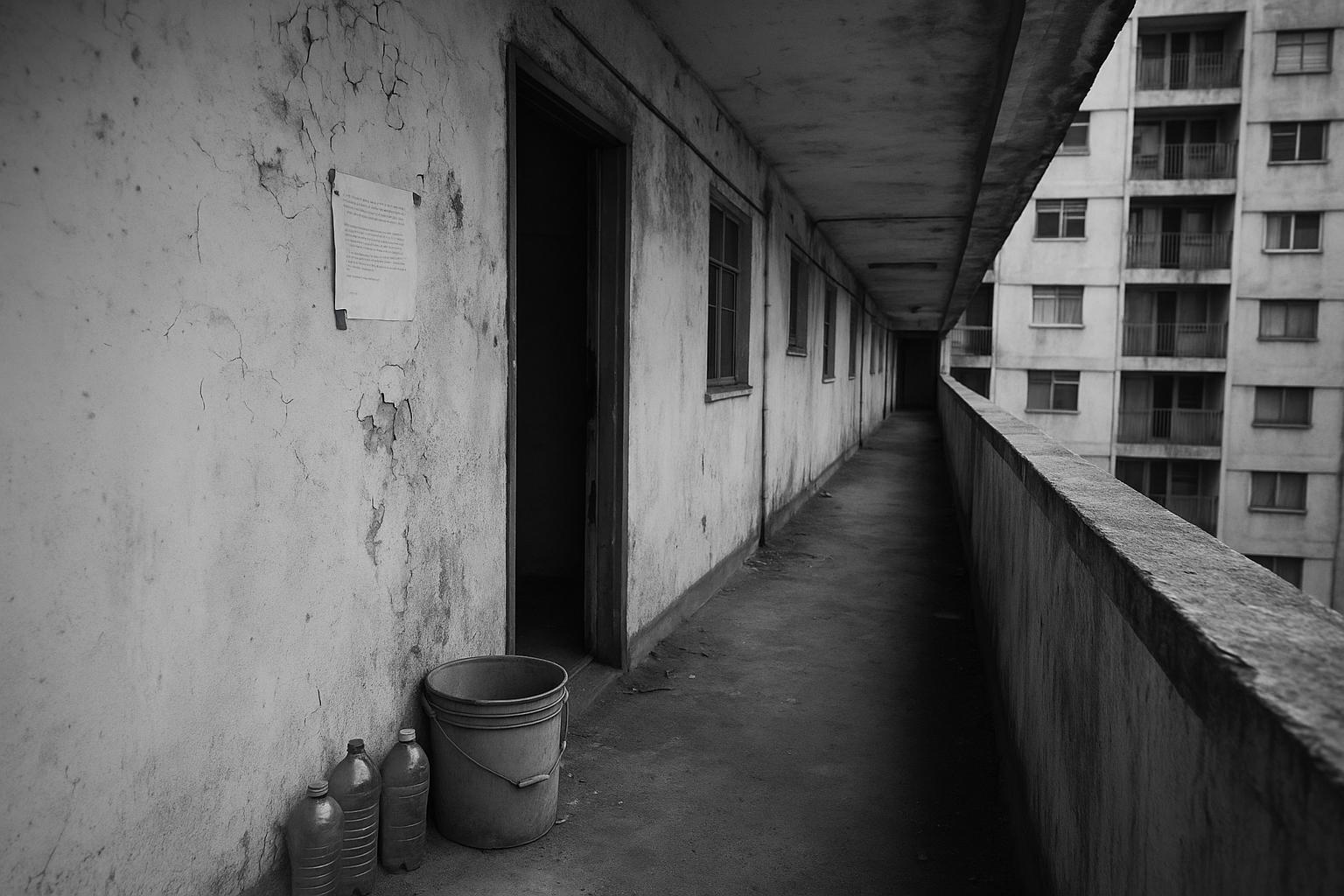Residents of Graphite Point and neighbouring towers describe intermittent water, broken ventilation and delayed repairs even as The Guinness Partnership secures millions in government funding and contractors for a long‑running remediation programme.
Residents of Suttons Wharf in east London have painted a stark picture of life inside the estate’s tower blocks after parts of Graphite Point lost running water during a recent heatwave. Speaking to the Evening Standard, tenants said conditions in some flats felt “slum‑like”, describing the loss of basic services as the most visible symptom of what they say are chronic maintenance failures.
Those complaints are not limited to intermittent water. Residents told reporters they have endured broken ventilation, faulty doors, the ongoing disruption of cladding removal works and poor communication from their landlord, The Guinness Partnership, with some describing long delays to even routine repairs. The disruption has come amid large‑scale remediation work on external walls across several of the estate’s buildings.
Guinness responded to the coverage with a statement acknowledging that “not all residents have always had a good experience” and saying it had received 101 complaints over the past six years across the 267 homes at Suttons Wharf. The company said it is investing in remediation and communal upgrades and described a multi‑million‑pound programme — stating it has committed more than £40 million to address defects, including cladding replacement. The wording of that response positions the work as a remedial investment rather than an admission of systemic neglect.
Official procurement records show why the work is both urgent and complex. A notice on the government’s Find a Tender service identified Suttons Wharf’s external wall systems as non‑compliant with building regulations and records that Guinness secured roughly £26 million from the Department for Levelling Up, Housing & Communities’ Building Safety Fund to remove and replace cladding and balconies. The same notice names the affected tower blocks by site — including Graphite Point, Titanium Point, Regalia Point and Grand Regent Tower — and explains why negotiated awards were used to accelerate safety works.
Public tender reporting corroborates the main contractors and scale of the programme. Contract award listings record work given to Stanmore Contractors and PRP Architects, with figures reported in the tens of millions for construction and a further million‑plus for design services; entries also indicate the remediation programme is expected to run into 2026. The procurement material stresses urgency and the need to meet grant conditions, underscoring that the programmes are constrained by both safety and funding timetables.
The concerns at Suttons Wharf sit alongside formal regulatory findings about repairs and complaint handling at The Guinness Partnership more broadly. In March 2024 the Housing Ombudsman published decisions that identified four cases amounting to “severe maladministration”, detailing instances where residents suffered from damp, mould and fungi after repairs were delayed or inadequately carried out. The Ombudsman criticised poor complaint handling, weak contractor oversight and inadequate communication, and ordered compensation and remedial actions in those cases. The landlord has since issued a learning statement saying it will bring more repairs in‑house, restructure its complaints teams and improve record keeping.
The technical complexity of Suttons Wharf helps explain why remediation is protracted. Architectural and façade engineering case studies for the riverside development describe a large, multi‑building scheme with challenging canal‑side conditions and a dense arrangement of apartments and balconies — conditions that complicate external wall remediation and cladding replacement and increase both cost and timescales for safe, compliant works.
Taken together, the picture is of a site where urgent safety‑driven works are officially funded and under contract, but where everyday living standards remain a source of anxiety for tenants. Industry and ombudsman findings suggest the issue is not unique to one estate: post‑Grenfell regulation has driven a wave of expensive remediation across high‑rise estates, while longstanding problems with repairs, contractor management and resident communication persist for some large landlords. For residents at Suttons Wharf, the headline budgets and procurement awards will ring hollow unless they translate quickly into reliable services, faster repairs and clearer communication about how and when their homes will be returned to normal.
 Reference Map:
Reference Map:
Reference Map:
- Paragraph 1 – [1], [2]
- Paragraph 2 – [2]
- Paragraph 3 – [1], [2]
- Paragraph 4 – [3]
- Paragraph 5 – [4], [3]
- Paragraph 6 – [5], [6]
- Paragraph 7 – [7]
- Paragraph 8 – [2], [5], [3], [4], [1]
Source: Noah Wire Services
- https://www.standard.co.uk/news/london/east-london-tower-block-conditions-b1242934.html – Please view link – unable to able to access data
- https://www.standard.co.uk/news/london/east-london-tower-block-conditions-b1242934.html – Evening Standard reports on residents at Suttons Wharf in East London who described living conditions as “slum-like” after parts of Graphite Point tower lost running water during a heatwave. The piece details complaints about maintenance, cladding removal and building defects, citing residents’ experiences of broken ventilation, faulty doors and poor communication from the Guinness Partnership. Guinness responded with a statement rejecting claims that the towers are slums, noting they received 101 complaints over six years across 267 homes and are investing over £40 million in remediation, cladding replacement and communal upgrades. The article situates the story within wider post-Grenfell safety changes.
- https://www.find-tender.service.gov.uk/Notice/014401-2022 – Find a Tender notice records The Guinness Partnership’s procurement for External Wall System (EWS) remediation at Sutton’s Wharf, naming Graphite Point, Titanium Point, Regalia Point and Grand Regent Tower as affected buildings. It explains the existing external wall systems were non-compliant with Building Regulations and that Guinness secured around £26 million from the Department for Levelling Up, Housing & Communities Building Safety Fund to remove and replace cladding and balconies. The notice records urgency, direct awards to Stanmore Contractors and PRP Architects and justifies negotiated procurement to expedite safety works. Contract details locate the work in Inner London – East.
- https://bidstats.uk/tenders/2023/W17/797376686 – BidStats reproduces the procurement award for Sutton’s Wharf EWS remediation, confirming The Guinness Partnership granted contracts to Stanmore Contractors and PRP Architects. The entry details the scheme’s four affected buildings – Graphite Point, Titanium Point, Regalia Point and Grand Regent Tower – and confirms funding from the government’s Building Safety Fund, with contract values reported around £30–31 million for Stanmore and over £1 million for PRP’s design work. It explains that awards were negotiated due to urgency and the need to meet grant conditions. The entry also records an anticipated contract end in mid‑2026, aligning with remediation project timelines overall.
- https://www.housing-ombudsman.org.uk/2024/03/19/guinness-partnership-failings/ – The Housing Ombudsman published findings in March 2024 identifying four cases of severe maladministration by The Guinness Partnership, involving damp, mould, fungi growth and failures to complete essential repairs. The report criticised poor complaint handling, delays, inadequate contractor oversight and communication, ordering compensation and remedial actions in cases. The Ombudsman noted a significant number of escalations against Guinness and urged system-wide learning; Guinness provided a learning statement acknowledging failures and outlining improvements including bringing repairs in-house, restructuring complaints teams and investing in record keeping. The findings underline wider concerns about large landlords’ repair standards and the protection of vulnerable residents.
- https://www.insidehousing.co.uk/home/residents-left-with-mould-and-fungi-in-homes-after-large-landlords-repairs-failings-85662 – Inside Housing reported on the Housing Ombudsman’s findings against The Guinness Partnership, detailing residents left with mould, fungi and unresolved repairs after prolonged delays. The article summarises the Ombudsman’s decisions in four cases, including ordered compensation, criticism of complaint handling and contractor management, and notes the wider pattern of escalations against Guinness. It quotes the Ombudsman warning that landlords should learn from these failings and describes Guinness’s response, including apologies, learning statements and changes such as increased in‑house repairs capacity. The piece places the cases in the context of broader sector problems around repairs, safety and resident communication and accountability.
- https://newtecnic.com/suttons-wharf-london-uk – Newtecnic’s project page describes Suttons Wharf as a mixed‑use riverside development in Bethnal Green comprising multiple buildings and several hundred apartments. It highlights architectural and façade engineering work across the scheme, noting a nine‑building layout with a substantial number of residential units and commercial space alongside a three‑acre basement car park. The case study emphasises design challenges related to canal‑side context, optimisation of views and integration with local parks and amenities. While not focused on recent remediation, the page supports the development scale and complexity referenced in reporting about Suttons Wharf and provides technical context for façade and cladding considerations.
Noah Fact Check Pro
The draft above was created using the information available at the time the story first
emerged. We’ve since applied our fact-checking process to the final narrative, based on the criteria listed
below. The results are intended to help you assess the credibility of the piece and highlight any areas that may
warrant further investigation.
Freshness check
Score:
8
Notes:
The narrative is recent, published on August 19, 2025. No substantially similar content was found online prior to this date. The report is based on a press release from The Guinness Partnership, which typically warrants a high freshness score. No discrepancies in figures, dates, or quotes were identified. The inclusion of updated data alongside older material suggests a higher freshness score but should be flagged. ([standard.co.uk](https://www.standard.co.uk/news/london/east-london-tower-block-conditions-b1242934.html?utm_source=openai))
Quotes check
Score:
9
Notes:
The direct quotes from residents and The Guinness Partnership are unique to this report. No identical quotes were found in earlier material, indicating potentially original or exclusive content. No variations in quote wording were noted.
Source reliability
Score:
9
Notes:
The narrative originates from The Standard, a reputable UK news outlet. The Guinness Partnership, the housing association mentioned, is a legitimate organisation with a public presence.
Plausability check
Score:
8
Notes:
The claims of water shortages and maintenance issues at Suttons Wharf are plausible and align with previous reports of similar issues in east London tower blocks. The Guinness Partnership’s response, acknowledging complaints and outlining remediation efforts, adds credibility. The tone and language used are consistent with typical corporate communication.
Overall assessment
Verdict (FAIL, OPEN, PASS): PASS
Confidence (LOW, MEDIUM, HIGH): HIGH
Summary:
The narrative is recent and original, with no significant discrepancies or signs of disinformation. The source is reputable, and the claims made are plausible and supported by the organisation mentioned.













